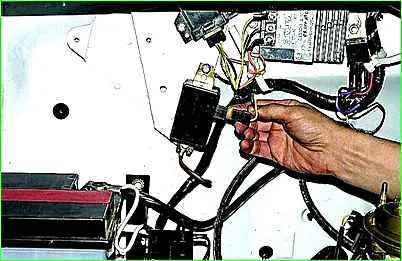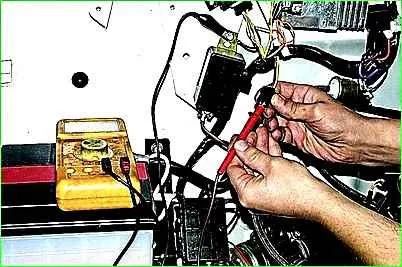The initial express check of the generator can be performed directly on the car
Checking the generator on cars with an engine type ZMZ-402
On cars with engines ZMZ-4025 and ZMZ-4026, generators 16.3701 or 191.3701 are installed, not equipped with a built-in voltage regulator.
These generators operate in conjunction with an external transistor voltage regulator type 13.3702-01 or 50.3702, which has electronic protection against short circuits in the generator excitation winding circuit.
It is more convenient to do the work together.
Start the engine, let it run for a few minutes, then, pressing the gas pedal, bring the crankshaft speed to 3000 min –1 .
We turn on consumers: high beam headlights; heater fan; wiper; alarm.
In this mode, we measure the voltage at the terminals of the battery, which should be above 12 V.
If this is not the case, the generator windings are faulty (break or short circuit), the voltage regulator with the brush assembly, the contact rings are oxidized or oiled, the brushes are worn out or “stuck.”
In order to verify that the voltage regulator is faulty, turn off all consumers except the side light and measure the voltage at speeds of 1000-1200 min –1, which should be in the range of 13.8-14.5 V .

To check the generator excitation circuit, disconnect the connecting block from the regulator.

Attach a voltmeter or test lamp to terminal “W” of the block and to the body of the voltage regulator.
Turn on the ignition
If there is no voltage (the lamp is not lit), one of the following malfunctions is possible: failure of contact of the excitation winding with the slip rings; break of the excitation winding; “hanging” of brushes in the channels of the brush holder; burning, oxidation and severe wear of the rotor contact rings.
Checking the generator on cars with an engine type ZMZ-405, ZMZ-406
On engines of the ZMZ-406 and ZMZ-405 families, generators 9422.3701 or 5122.3771 with built-in integrated voltage regulators are installed.
Start the engine, let it run for a few minutes, then, pressing the gas pedal, bring the crankshaft speed to 3000 min –1 .
We turn on consumers: high beam headlights; heater fan; wiper; alarm
We measure the voltage at the terminals of the battery, which should be above 12 V.
If this is not the case, the generator windings are faulty (break or short circuit), the voltage regulator with the brush assembly, the excitation winding rings are oxidized or oiled, the brushes are worn out or “stuck.”
In order to verify that the voltage regulator is faulty, we turn off all consumers except the side light and measure the voltage at 1000-1200 min –1, which should be in the range of 13.5-14.2 V .
The removed voltage regulator can be checked as follows.
Connect a lamp (21-35 W, 12 V) between the brushes.
Connect +12 V to the “D” terminal, and “minus” to the “ground” terminal.
The lamp should light up, and when the source voltage increases within 13.5–14.2 V, it should go out.
If the lamp lights up in both cases, replace the regulator.
Checking the diodes of the rectifier unit and additional diodes can be found in the article - “Generator 9422.3701 GAZ-2705”
If its elements fail, we recommend replacing the rectifier unit as an assembly.
It is possible to replace individual diodes, but they will need to be re-pressed into the holder - an operation that requires care and skill.





